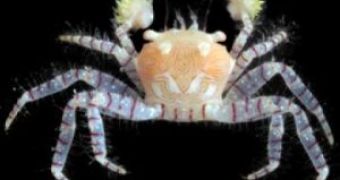A three-week research expedition to the remote French Frigate Shoals in the Northwestern Hawaiian Islands Marine National Monument, with the goal of assessing coral reef biodiversity in the largest fully protected marine area, turned back with the discovery of 100 new species for that area, including many that are new to science.
The research team included world-renowned taxonomists (biologists specializing in identifying and naming organisms). Annual reef assessment and monitoring program surveys are conducted throughout the Northwestern Hawaiian Islands, but they focus on fishes, corals, macroalgae and macroinvertebrates (lobsters, large crabs, sea urchins).
Instead, this expedition focused on the more cryptic small invertebrates (tiny crabs, mollusks, sea slugs, worms, corals, sea cucumbers, sea stars), algae, and microbes. These species are often overlooked, but they make up the majority of living diversity on coral reefs.
These organisms are not as appealing as Hawaiian monk seals or sharks, but they are the basis for the existence of the larger animals, and changes in their populations are often the first indicators of environmental changes. "It was a very successful expedition by almost any criterion, and the discovery phase has really only just begun. In the coming months, and even over the next several years, we will be conducting morphological examinations and analyzing genetic sequence data in order to further identify and classify these organisms, and possibly to shed some light on where these species originated," said Dr. Joel W. Martin of the Natural History Museum of Los Angeles County.
"What we did not find is also important. There were several groups of animals that we expected to find but did not find, or found only rarely, such as porcellanid crabs. The apparent absence of these common reef organisms may provide insight into how the unique flora and fauna of French Frigate Shoals came to be."
The research led to the discovery of 160 unique species of seaweed. More than 200 samplings were conducted, with more than 2,500 recorded collections. Scientists discovered multicolored worms; a bright purple, foot-long sea star; and a hermit crab that dons a sea anemone and sports shiny golden claws amongst other captures.
Dr. Jim Maragos, a coral expert with the U.S. Fish and Wildlife Service's Pacific Remote Islands National Wildlife Refuge Complex who has worked in the Northwestern Hawaiian Islands for over 6 years has discovered as many as 11 new species of coral and 18 new records at French Frigate Shoals, and one species is so unique that specialists cannot even place it in a known category. Water and sand samples will be studied at the Woods Hole Oceanographic Institution in Massachusetts and they will surely lead to new discoveries. "It was a very successful expedition by almost any criterion, and the discovery phase has really only just begun," said Martin.
These studies will determine how well the ecosystem is being managed and what menaces it confronts. Coral reefs possess an extraordinary and very little studied biodiversity, being named " the rainforests of the sea", but they are also highly threatened.
According to Dr. Nancy Knowlton of Scripps Institution of Oceanography at UC San Diego "We don't even know to the nearest order of magnitude the number of species living in the coral reefs around the globe. Our best guess is somewhere between 1 and 9 million species based on comparisons with the diversity found in rainforests and a partial count of organisms living in a tropical aquarium."
Dr. Gustav Paulay, Curator of Invertebrates for the Florida Museum of Natural History and an expert on tropical Pacific coral reef invertebrates, said "the information gained from this expedition will help us to understand the evolution of life in the Northwestern Hawaiian Islands, and provide a biogeographic baseline to study the pathways by which marine organisms have spread throughout the archipelago."
Photo credit: Joel Martin. A crab species discovered during this expedition

 14 DAY TRIAL //
14 DAY TRIAL //